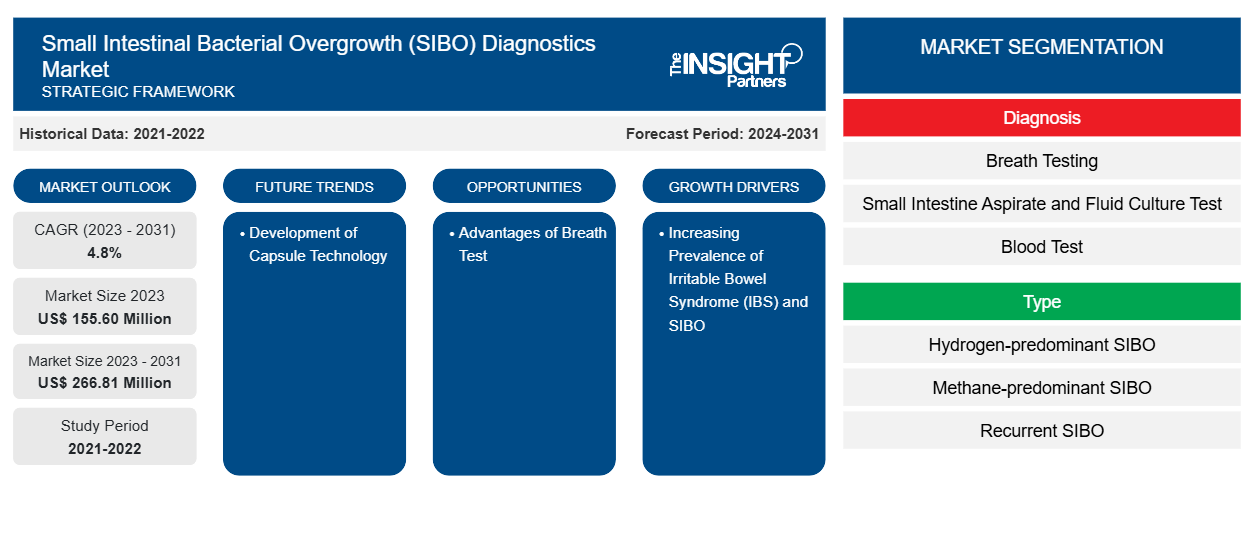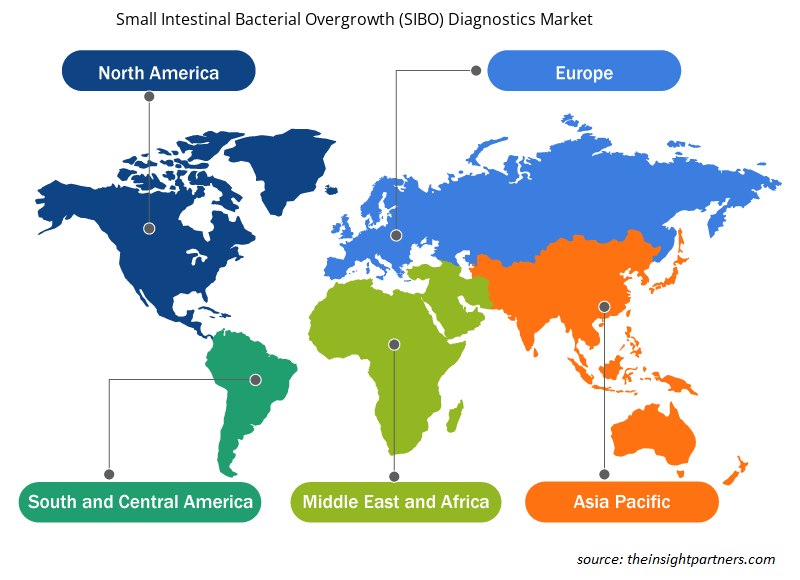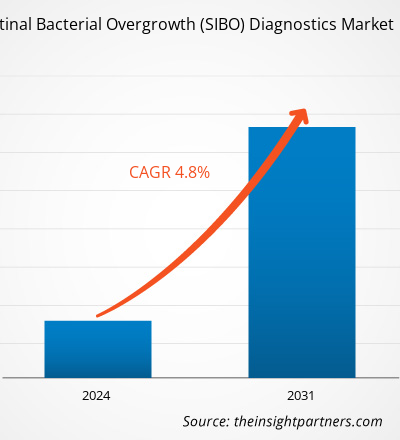Si prevede che il mercato della diagnostica della proliferazione batterica dell'intestino tenue (SIBO) raggiungerà i 266,81 milioni di dollari entro il 2031, rispetto ai 155,60 milioni di dollari del 2023. Si prevede che il mercato registrerà un CAGR del 4,8% nel periodo 2023-2031. È probabile che le tecnologie di sequenziamento di nuova generazione per diagnosticare la SIBO rimangano una tendenza chiave nel mercato.
Analisi di mercato della diagnostica della proliferazione batterica dell'intestino tenue (SIBO)
L'aumento dell'incidenza di SIBO, la crescente domanda di test diagnostici non invasivi e i progressi tecnologici nei test diagnostici stanno alimentando la crescita del mercato della diagnostica della proliferazione batterica dell'intestino tenue (SIBO). Inoltre, la crescente attenzione alla salute intestinale e digestiva, l'espansione delle infrastrutture sanitarie e la crescente consapevolezza e istruzione sulla SIBO tra i professionisti sanitari e i pazienti stanno guidando la crescita del mercato della diagnostica della proliferazione batterica dell'intestino tenue (SIBO)
Panoramica del mercato della diagnostica della proliferazione batterica dell'intestino tenue (SIBO)
Geograficamente, si prevede che l'Asia Pacifica registrerà il CAGR più elevato nel periodo di previsione 2023-2031. L'India è tra le nazioni in più rapido sviluppo al mondo ed è tra i principali paesi leader dell'Asia Pacifica. L'India è il paese in più rapido sviluppo nella regione Asia Pacifica. Ha aziende consolidate che operano nel settore della biotecnologia e dei dispositivi medici. Inoltre, un numero crescente di startup sta introducendo apparecchiature di laboratorio che utilizzano le ultime tecnologie. Mentre, l'aumento dei casi di diarrea, SIBO e malattie gastrointestinali amplia le opportunità di crescita per il mercato della diagnostica della proliferazione batterica intestinale tenue (SIBO) in India. Allo stesso modo, il crescente numero di ospedali e laboratori diagnostici in tutto il paese probabilmente aumenterà la domanda di strumenti e attrezzature diagnostiche modernizzate , offrendo un ambiente favorevole per il mercato della diagnostica della proliferazione batterica intestinale tenue in India durante il periodo di previsione.
Personalizza questo report in base alle tue esigenze
Riceverai la personalizzazione gratuita di qualsiasi report, comprese parti di questo report, o analisi a livello nazionale, pacchetto dati Excel, oltre a usufruire di grandi offerte e sconti per start-up e università
Mercato della diagnostica della proliferazione batterica dell'intestino tenue (SIBO): approfondimenti strategici

-
Scopri le principali tendenze di mercato in questo rapporto.Questo campione GRATUITO includerà analisi di dati che spaziano dalle tendenze di mercato alle stime e alle previsioni.
Driver di mercato e opportunità per la diagnostica della sovracrescita batterica dell'intestino tenue (SIBO)
L'aumento della prevalenza della sindrome dell'intestino irritabile (IBS) favorisce il mercato
La sindrome dell'intestino irritabile (IBS) è il disturbo gastrointestinale comunemente diagnosticato con dolore addominale e alterazioni delle abitudini intestinali che si traducono in sintomi associati come gonfiore, malassorbimento e sintomi sistemici. Il morbo di Crohn e la colite ulcerosa sono tipi di IBS. Provoca gonfiore nel tratto digerente, che può causare dolore addominale, diarrea, affaticamento, perdita di peso e malnutrizione. Secondo MedlinePlus, il morbo di Crohn è più diffuso nell'Europa occidentale e nel Nord America, con un tasso di prevalenza di 100-300 ogni 100.000 persone. Secondo i dati di Medscape, l'incidenza della colite ulcerosa negli Stati Uniti è di 10,4-12 casi ogni 100.000 persone e il tasso di prevalenza è di 35-100 casi ogni 100.000 persone. Rispetto al morbo di Crohn, la colite ulcerosa è tre volte più comune. Si ritiene che l'IBD sia il risultato di una moltitudine di interazioni ambientali e batteriche con fattori immunomediati in un ospite geneticamente suscettibile. La crescente prevalenza dell'IBS in tutto il mondo è dovuta al cambiamento dello stile di vita e delle abitudini alimentari. La proliferazione batterica dell'intestino tenue (SIBO) è ampiamente associata all'IBS. Pertanto, la crescente prevalenza dell'IBS alimenta la crescita del mercato della diagnostica SIBO poiché aumenta la prevalenza di SIBO.
Lo sviluppo della tecnologia delle capsule rappresenta un'opportunità per la crescita del mercato
I crescenti sviluppi tecnologici nel campo dei dispositivi medici hanno offerto vari prodotti innovativi per diagnosticare diverse complesse condizioni di salute umana. Pertanto, per diagnosticare la SIBO, è in fase di sviluppo una tecnologia innovativa di capsule ingerite per via orale. È progettata in modo da misurare in vivo l'idrogeno e l'anidride carbonica dopo l'ingestione di un pasto a base di carboidrati e fornire un'alternativa tecnologicamente aggiornata all'attuale test dell'idrogeno nel respiro. Si prevede che la tecnologia delle capsule aiuterà a diagnosticare campioni di batteri dell'intestino tenue. Pertanto, è probabile che l'introduzione della tecnologia delle capsule emerga nel prossimo futuro e contribuisca alla valutazione diretta e accurata della SIBO e offra opportunità di crescita vitali per la crescita del mercato.
Analisi della segmentazione del rapporto di mercato sulla diagnostica della proliferazione batterica dell'intestino tenue (SIBO)
I segmenti chiave che hanno contribuito alla derivazione dell'analisi di mercato della diagnostica della proliferazione batterica dell'intestino tenue (SIBO) sono il prodotto e l'utente finale.
- In base al prodotto, il mercato della diagnostica della proliferazione batterica dell'intestino tenue (SIBO) è suddiviso in test del respiro, test dell'aspirato dell'intestino tenue e della coltura dei fluidi, analisi del sangue e altri. I tipi di test del respiro sono ulteriormente suddivisi in test del respiro con xilosio 14C, test del respiro con idrogeno, test del respiro con acido glicocolico 14C e altri. Il segmento dei test del respiro ha detenuto la quota di mercato maggiore nel 2023.
- In base al tipo, il mercato della diagnostica della sovracrescita batterica dell'intestino tenue (SIBO) è suddiviso in SIBO a predominanza di idrogeno, SIBO a predominanza di metano e SIBO ricorrente. Il segmento SIBO a predominanza di idrogeno ha detenuto la quota di mercato maggiore nel 2023.
Analisi della quota di mercato della diagnostica della sovracrescita batterica dell'intestino tenue (SIBO) per area geografica
L'ambito geografico del rapporto di mercato sulla diagnostica della proliferazione batterica dell'intestino tenue (SIBO) è suddiviso principalmente in cinque regioni: Nord America, Asia Pacifico, Europa, Medio Oriente e Africa, e Sud e Centro America.
Il Nord America ha dominato il mercato. Il Nord America è il mercato più grande nel periodo di previsione a causa della crescente incidenza di SIBO nei paesi, del crescente supporto governativo e del crescente numero di introduzioni di prodotti. Inoltre, è probabile che anche la crescente domanda di infrastrutture diagnostiche avanzate acceleri la crescita del mercato durante il periodo di previsione. Gli Stati Uniti sono il paese più grande e in più rapida crescita per il mercato della diagnostica della proliferazione batterica dell'intestino tenue (SIBO) nel mercato globale. La crescita del mercato è principalmente attribuita alla crescente prevalenza di condizioni come sindromi da immunodeficienza e insufficienza pancreatica esocrina tra le altre. Si prevede inoltre che la crescente prevalenza di fattori di rischio associati alla SIBO guiderà la prevalenza della condizione, che alla fine offrirà un ambiente favorevole per la crescita del mercato della diagnostica della proliferazione batterica dell'intestino tenue negli Stati Uniti.
Approfondimenti regionali sul mercato della diagnostica della proliferazione batterica dell'intestino tenue (SIBO)
Le tendenze regionali e i fattori che influenzano il mercato della diagnostica della proliferazione batterica dell'intestino tenue (SIBO) durante il periodo di previsione sono stati ampiamente spiegati dagli analisti di Insight Partners. Questa sezione discute anche i segmenti del mercato della diagnostica della proliferazione batterica dell'intestino tenue (SIBO) e la geografia in Nord America, Europa, Asia Pacifico, Medio Oriente e Africa e Sud e Centro America.

- Ottieni i dati specifici regionali per il mercato della diagnostica della proliferazione batterica dell'intestino tenue (SIBO)
Ambito del rapporto di mercato sulla diagnostica della proliferazione batterica dell'intestino tenue (SIBO)
| Attributo del report | Dettagli |
|---|---|
| Dimensioni del mercato nel 2023 | 155,60 milioni di dollari USA |
| Dimensioni del mercato entro il 2031 | 266,81 milioni di dollari USA |
| CAGR globale (2023-2031) | 4,8% |
| Dati storici | 2021-2022 |
| Periodo di previsione | 2024-2031 |
| Segmenti coperti |
Per diagnosi
|
| Regioni e Paesi coperti |
America del Nord
|
| Leader di mercato e profili aziendali chiave |
|
Diagnostica della sovracrescita batterica dell'intestino tenue (SIBO) Densità degli attori del mercato: comprendere il suo impatto sulle dinamiche aziendali
Il mercato della diagnostica per la sovracrescita batterica dell'intestino tenue (SIBO) sta crescendo rapidamente, spinto dalla crescente domanda degli utenti finali dovuta a fattori quali l'evoluzione delle preferenze dei consumatori, i progressi tecnologici e una maggiore consapevolezza dei benefici del prodotto. Con l'aumento della domanda, le aziende stanno ampliando la propria offerta, innovando per soddisfare le esigenze dei consumatori e capitalizzando sulle tendenze emergenti, il che alimenta ulteriormente la crescita del mercato.
La densità degli operatori di mercato si riferisce alla distribuzione di aziende o società che operano in un particolare mercato o settore. Indica quanti concorrenti (operatori di mercato) sono presenti in un dato spazio di mercato in relazione alle sue dimensioni o al valore di mercato totale.
Le principali aziende che operano nel mercato della diagnostica della proliferazione batterica dell'intestino tenue (SIBO) sono:
- Diagnostica Genova
- Diagnosi SIBO
- Diagnostica Internazionale del Commonwealth
- Aerodiagnostica LLC
- Test SIBO
- Soluzioni metaboliche Inc.
Disclaimer : le aziende elencate sopra non sono classificate secondo un ordine particolare.

- Ottieni la panoramica dei principali attori del mercato della diagnostica della sovracrescita batterica dell'intestino tenue (SIBO)
Notizie di mercato e sviluppi recenti sulla diagnostica della sovracrescita batterica dell'intestino tenue (SIBO)
Il mercato della diagnostica della proliferazione batterica dell'intestino tenue (SIBO) viene valutato raccogliendo dati qualitativi e quantitativi dopo la ricerca primaria e secondaria, che include importanti pubblicazioni aziendali, dati di associazioni e database. Di seguito sono elencati alcuni degli sviluppi nel mercato della diagnostica della proliferazione batterica dell'intestino tenue (SIBO):
- Owlstone Medical ha lanciato OMED Health, un marchio dedicato e incentrato sul paziente e una piattaforma digitale che offrirà a pazienti e medici l'accesso a test diagnostici basati sul respiro, dispositivi point-of-care (PoC) e risorse di supporto per una serie di condizioni. Inizialmente focalizzato sulle malattie digestive, OMED Health aiuterà le persone con problemi di salute intestinale ad avere una migliore qualità della vita consentendo una migliore e più rapida comprensione e gestione delle loro condizioni. (Fonte: Owlstone Medical, comunicato stampa, aprile 2023)
Copertura e risultati del rapporto di mercato sulla diagnostica della sovracrescita batterica dell'intestino tenue (SIBO)
Il rapporto "Dimensioni e previsioni del mercato della diagnostica della sovracrescita batterica dell'intestino tenue (SIBO) (2021-2031)" fornisce un'analisi dettagliata del mercato che copre le seguenti aree:
- Dimensioni e previsioni del mercato della diagnostica della proliferazione batterica dell'intestino tenue (SIBO) a livello globale, regionale e nazionale per tutti i principali segmenti di mercato coperti dall'ambito
- Tendenze del mercato della diagnostica della proliferazione batterica dell'intestino tenue (SIBO) e dinamiche di mercato quali fattori trainanti, limitazioni e opportunità chiave
- Analisi dettagliata delle cinque forze PEST/Porter e SWOT
- Analisi di mercato della diagnostica della proliferazione batterica dell'intestino tenue (SIBO) che copre le principali tendenze di mercato, il quadro globale e regionale, i principali attori, le normative e i recenti sviluppi del mercato
- Analisi del panorama industriale e della concorrenza che copre la concentrazione del mercato, l'analisi della mappa di calore, i principali attori e gli sviluppi recenti per il mercato della diagnostica della proliferazione batterica dell'intestino tenue (SIBO)
- Profili aziendali dettagliati
- Analisi storica (2 anni), anno base, previsione (7 anni) con CAGR
- Analisi PEST e SWOT
- Valore/volume delle dimensioni del mercato - Globale, Regionale, Nazionale
- Industria e panorama competitivo
- Set di dati Excel
Report recenti
Testimonianze
Motivo dell'acquisto
- Processo decisionale informato
- Comprensione delle dinamiche di mercato
- Analisi competitiva
- Analisi dei clienti
- Previsioni di mercato
- Mitigazione del rischio
- Pianificazione strategica
- Giustificazione degli investimenti
- Identificazione dei mercati emergenti
- Miglioramento delle strategie di marketing
- Aumento dell'efficienza operativa
- Allineamento alle tendenze normative






















 Ottieni un campione gratuito per - Mercato della diagnostica della proliferazione batterica dell'intestino tenue (SIBO)
Ottieni un campione gratuito per - Mercato della diagnostica della proliferazione batterica dell'intestino tenue (SIBO)